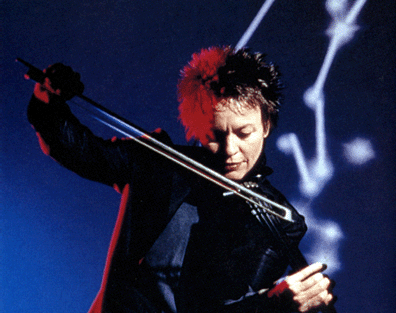![]() Criticism
Criticism
![]() Criticism
Criticism
Laurie Anderson orbits
between
pop and art
 Performer’s music and musings
Performer’s music and musings
charm Vancouver audience
THE END OF THE MOON
Laurie Anderson in concert
Centre for the Performing Arts, Nov. 14
by David Gordon Duke
After more than two decades of defining performance art, Laurie Anderson is somewhere between a phenomenon and a cult figure. Her local fans were out in full Sunday to see The End of the Moon, a new entertainment purportedly about Anderson's time as NASA's first — and last — artist-in-residence.
The set for her one-woman show is starkly simple: a few dozen candles on the floor, an easy chair on the left, balanced by an image of the moon's surface on the right, and stands and various electronic equipment front and centre. Anderson moves from station to station, but the performance is essentially static. Lighting appears simple and unobtrusive but is the key element in the flow of ideas and moods.
Anderson’s basic dynamic is interplay between text and music. She delivers stories and stand-up, parables and sermons over simple electronic vamps. Brief musical interludes — more electronics triggered by live electronic viola — amplify moods or act as commentary. Longer set-pieces merge spoken dialogue with self-performed accompaniment.
As Anderson’s texts move from reminiscences to near-rants, she modulates the timbre of her voice and its degree of amplification; the style of delivery ranges from informal chat to stylized intonations. Much of the material is amusing; humour is central to the pacing and leavens Anderson’s philosophical and political musings.
Notwithstanding the avant-garde aura of performance art, Anderson is all about exploring the thin, fuzzy line between “popular” culture and “art.” Her perspective, with its references to Mission Control, Houston, post-9/11 New York, the Iraq War, and Zen retreats in northern California, is unmistakably American. In essence she's successfully reinvigorated the tradition of the cracker-barrel philosopher for a new century's urban villagers.
Although irony is the primary weapon in Anderson's arsenal of rhetoric, she misses (or perhaps chooses to ignore) the ironies of her own artistic condition: the dubious origins of the electronic technology that makes her art possible, the very commercial underpinnings of her career, and, perhaps most telling, the conspicuous triteness of her musical lexicon. For all its theatricality, Anderson’s music is neither sophisticated nor particularly original. But the same comment could just as easily apply to the music of a Harry Partch or an Eric Satie.
Ultimately, none of the elements of her art is entirely compelling in and of themselves; it's the amalgam that fascinates and charms. And it’s Laurie Anderson, not her material, that’s the great original.
Vancouver Sun
16 November 2004
 archives
archives